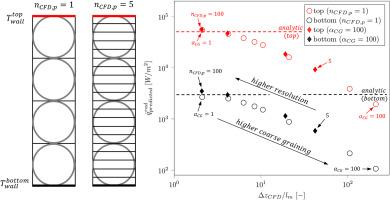粗粒度CFD-DEM模拟中的高级热通量建模
IF 4.3
2区 材料科学
Q2 ENGINEERING, CHEMICAL
引用次数: 0
摘要
在粗粒度CFD-DEM模拟中准确预测热通量是一个重大挑战。具体而言,流体-颗粒热交换率、颗粒床的有效导热率以及辐射传热率难以预测。通过使用一种新的算法,我们显著提高了这种使用换热限制器的模拟的准确性和稳定性。即使在比典型流体热松弛时间大三个数量级的时间步长下,该限制器也能实现现实的预测。此外,还开发了基于视点因子的辐射热交换计算校正。这些修正确保了在粗粒化比为10的情况下,有效的热导率误差小于3%。本文还研究了P1辐射模型在粗粒度环境中的适用性,从而为CFD网格分辨率提供建议,以确保准确的预测。我们的方法显著提高了稳定性、准确性和计算效率,使粗粒度的CFD-DEM模拟更适用于工业应用。这些进步使高温过程的建模更加可靠,加速了优化研究,并使这些过程的虚拟设备设计成为可能。本文章由计算机程序翻译,如有差异,请以英文原文为准。

Advanced heat flux modeling in coarse-grained CFD-DEM simulations
Accurately predicting heat flux in coarse-grained CFD-DEM simulations is a significant challenge. Specifically, the rates of fluid-particle heat exchange, the effective thermal conductivity of a bed of particles, as well as radiative heat transfer rates are difficult to predict. By using a novel algorithm, we significantly improve the accuracy and stability of such simulations by using a heat exchange limiter. This limiter enables realistic predictions even at time steps that are three orders of magnitude larger than a typical fluid heat relaxation time. Additionally, view-factor-based corrections for radiative heat exchange computations are developed. These corrections ensure an effective thermal bed conductivity with less than 3 % error for a coarse-graining ratio of 10. The applicability of the P1 radiation model in coarse-grained settings is also examined, leading to recommendations for the CFD grid resolution to ensure accurate predictions. Our methods significantly enhance stability, accuracy, and computational efficiency, making coarse-grained CFD-DEM simulations more viable for industrial applications. These advancements enable more reliable modeling of high-temperature processes, accelerate optimization studies, and enable virtual equipment design of such processes.
求助全文
通过发布文献求助,成功后即可免费获取论文全文。
去求助
来源期刊

Particuology
工程技术-材料科学:综合
CiteScore
6.70
自引率
2.90%
发文量
1730
审稿时长
32 days
期刊介绍:
The word ‘particuology’ was coined to parallel the discipline for the science and technology of particles.
Particuology is an interdisciplinary journal that publishes frontier research articles and critical reviews on the discovery, formulation and engineering of particulate materials, processes and systems. It especially welcomes contributions utilising advanced theoretical, modelling and measurement methods to enable the discovery and creation of new particulate materials, and the manufacturing of functional particulate-based products, such as sensors.
Papers are handled by Thematic Editors who oversee contributions from specific subject fields. These fields are classified into: Particle Synthesis and Modification; Particle Characterization and Measurement; Granular Systems and Bulk Solids Technology; Fluidization and Particle-Fluid Systems; Aerosols; and Applications of Particle Technology.
Key topics concerning the creation and processing of particulates include:
-Modelling and simulation of particle formation, collective behaviour of particles and systems for particle production over a broad spectrum of length scales
-Mining of experimental data for particle synthesis and surface properties to facilitate the creation of new materials and processes
-Particle design and preparation including controlled response and sensing functionalities in formation, delivery systems and biological systems, etc.
-Experimental and computational methods for visualization and analysis of particulate system.
These topics are broadly relevant to the production of materials, pharmaceuticals and food, and to the conversion of energy resources to fuels and protection of the environment.
 求助内容:
求助内容: 应助结果提醒方式:
应助结果提醒方式:


